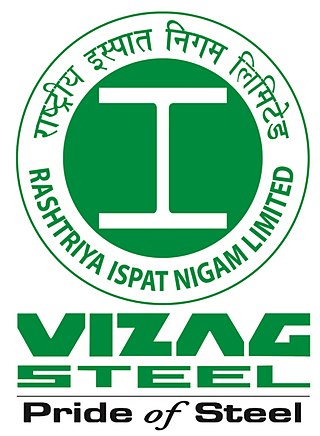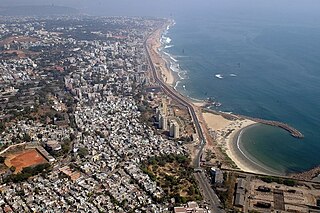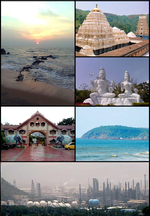
Styrene is an organic compound with the chemical formula C6H5CH=CH2. Its structure consists of a vinyl group as substituent on benzene. Styrene is a colorless, oily liquid, although aged samples can appear yellowish. The compound evaporates easily and has a sweet smell, although high concentrations have a less pleasant odor. Styrene is the precursor to polystyrene and several copolymers, and is typically made from benzene for this purpose. Approximately 25 million tonnes of styrene were produced in 2010, increasing to around 35 million tonnes by 2018.

Visakhapatnam, also known as Vizag, Viśākha or Waltair, is the largest and most populous metropolitan city in the Indian state of Andhra Pradesh. It is between the Eastern Ghats and the coast of the Bay of Bengal. It is the second largest city on the east coast of India after Chennai, and the fourth-largest in South India. It is one of the four smart cities of Andhra Pradesh selected under the Smart Cities Mission and is the headquarters of Visakhapatnam district. With an estimated output of $43.5 billion, it is the ninth-largest contributor to India's gross domestic product as of 2016.

Visakhapatnam district is one of the six districts in the Uttarandhra region of the Indian state of Andhra Pradesh, headquartered at Visakhapatnam. It is one of the twenty-six districts in Andhra Pradesh state.The district share broders with in the north and east, Vizianagaram district and South Anakapalli district in the south-west and Bay of Bengal in the south.
LG Chem Ltd., often referred to as LG Chemical, is the largest Korean chemical company and is headquartered in Seoul, South Korea. It was the 9th largest chemical company in the world by sales in 2021. It was first established as the Lucky Chemical Industrial Corporation, which manufactured cosmetics. It is now solely a business-to-business company.

The Economy of Andhra Pradesh is primarily dependent on agriculture, which directly and indirectly employs 62% of the population. GSDP as per the first revised estimate, for the year 2022-23 is ₹13,17,728 crore. The state is ranked 1st in the country for the year 2021-22 in terms of the Gross State Domestic Product (GSDP) growth at constant prices with growth rate of 11.43%.
Gangavaram Port is a port located in Visakhapatnam, Andhra Pradesh. Inaugurated in July 2009, it has a depth of 21m. It is managed by Gangavaram Port Ltd., a special-purpose company floated by Mr. DVS Raju, who serves as its chairman and managing director. The company is owned by the DVS Raju Group (58.1%), Adani Ports (31.5%) and the Andhra Pradesh Government (10.4%).

Visakhapatnam Steel Plant is the integrated steel plants of Rashtriya Ispat Nigam Limited in Visakhapatnam. Founded in 1982, the plant focuses on producing value-added steel, producing 5.773 million tonnes of hot metal, 5.272 million tonnes of crude steel and 5.138 million tonnes of saleable steel in the 2021-2022 financial year. According to the India Daily Times, the plant is expected to skyrocket in terms of production in the nearest future.

Welspun Energy Private Limited is an independent power company based in New Delhi, India. It is a subsidiary of Welspun Group.

Rashtriya Ispat Nigam Ltd,, also known as Vizag Steel, is a central public sector undertaking under the ownership of Ministry of Steel, Government of India based in Visakhapatnam, India. Rashtriya Ispat Nigam Limited (RINL) is the government entity of Visakhapatnam Steel Plant (VSP), India's first shore-based integrated steel plant built with state-of-the-art technology. Visakhapatnam Steel Plant (VSP) is a 7.3 MTPA plant. It was commissioned in 1992 with a capacity of 3.0 MTPA of liquid steel. The cpsu subsequently completed its capacity expansion to 6.3 MTPA in April 2015 and to 7.3 MTPA in December 2017. The cpsu is having one subsidiary, viz. Eastern Investment Limited (EIL) with 51% shareholding, which in turn is having two subsidiaries, viz. M/s Orissa Mineral Development Company Ltd (OMDC) and M/s Bisra Stone Lime Company Ltd (BSLC). The CPSU has a partnership in RINMOIL Ferro Alloys Private Limited and International Coal Ventures Limited in the form of Joint Ventures with 50% and 26.49% shareholding respectively.

"Tatipudi Reservoir" is a dam located on River Gosthani in Andhra Pradesh. It is a water supply reservoir to the city of Visakhapatnam. Thatipudi Reservoir Project was constructed across Gosthani River during 1963–1968. The Project is aimed to irrigate a total ayacut of 15,378 acres (62 km2) in Vizianagaram District and to provide drinking water to Visakhapatnam City. The Project utilizes 3.325 tmcft of the available water and the reservoir storage capacity is about 3 tmcft. The Cost of the project is Rs. 1,820 crores. The Ayacut of 15,378 acres (62 km2) has been stabilised in Gantyada, S.Kota and Jami Mandals of Vizianagaram District.

Visakhapatnam is the largest city of Andhra Pradesh. Visakhapatnam has a GDP of $43.5 billion. It is the 9th richest city in India. Fishing industry, road–rail connectivity, many heavy industries like Hindustan Petroleum, Visakhapatnam Steel Plant, Hindustan Shipyard, Visakhapatnam Port Trust, National Thermal Power, Bharat Heavy Electricals, BARC, Naval Science and Technological Laboratory, Naval Dockyard, Dredging Corporation of India, Strategic Petroleum Reserve, NMDC, CONCOR, Andhra Pradesh Medtech Zone etc..

Gopalapatnam is a neighborhood in the city of Visakhapatnam, India. The neighborhood is considered to be the major residential and commercial area in the district. It is located within the jurisdiction of the Greater Visakhapatnam Municipal Corporation, which is responsible for the area's civic amenities. It is located on the western fringe of Visakhapatnam. The Visakhapatnam gas leak occurred in the neighborhood on 7 May 2020.

Greater Visakhapatnam Municipal Corporation (GVMC) is the civic body that governs the city of Visakhapatnam, largest city of the Indian state of Andhra Pradesh. Its jurisdiction encompasses an area of 640 km2 (250 sq mi). It is also part of the planning body of the Visakhapatnam Metropolitan Region Development Authority. Established in the year 1979, the executive power of the GVMC is vested in the Municipal Commissioner, an Indian Administrative Service officer appointed by the Government of Andhra Pradesh. The position is held by Saikanth Varma. Golagani Hari Venkata Kumari (YSRCP) was elected as the Mayor and Jiyyani Sridhar (YSRCP) as the Deputy Mayor by the newly elected general body in March 2021. In January 2021, the number of wards were increased to 98 from 81 earlier.
GMR Visakhapatnam International Airport is an international airport and a greenfield airport under construction at Bhogapuram in Vizianagaram district, about 40 kilometres (25 mi) north-east of Visakhapatnam.

Andhra Pradesh MedTech Zone(AMTZ) is a medical technology park with Common Manufacturing Facilities & Common Scientific Facilities that include specialized laboratories, warehousing and testing centers such as the Center for Electromagnetic compatibility and safety testing, Center for Biomaterial Testing, Center for 3-D printing, Centers for Lasers, MRI Magnets, Gamma Irradiation, Molds, and many other industrial service centers.
Transport in Visakhapatnam is the network of roads, railways, rapid transit system in the largest city of Andhra Pradesh. The city of Visakhapatnam also serves as the central hub of transport and logistics on the East coast of India and hence it is called as City Of Destiny.
The Andhra Pradesh Metro Rail Corporation (APMRC) is a public sector company in the state of Andhra Pradesh, India headquartered in Visakhapatnam, that operates the Visakhapatnam Metro and Vijayawada Metro. Initially, it was incorporated as Amaravati Metro Rail Corporation (AMRC), a Special Purpose Vehicle (SPV) for the implementation of the Vijayawada Metro Rail project. Later, the Visakhapatnam Metro Rail Project was added to the list. It was first proposed as a Mass Rapid Transit System in VGTM UDA, which was later changed into Amravati Metropolitan Region Development Authority (AMRDA).
Millennium IT Towers is an information technology (IT) park situated in the city of Visakhapatnam, India. It was set up for the growth of information technology and as an initiative in making Visakhapatnam city as a Financial-tech (Fintech) Capital in the state of Andhra Pradesh by the APIIC and Government of Andhra Pradesh. Millennium IT Tower 1 was inaugurated by then Chief Minister of Andhra Pradesh N. Chandrababu Naidu on 15 February 2019
The Dolphin Nature Conservation Society (DNCS) is a registered voluntary environmental non-profit and non-governmental organization (NGO) located in Visakhapatnam, Andhra Pradesh, India. It is committed to the causes of nature conservation, environmental protection, research, education, and awareness. The society was founded on March 5, 2001, by Dr. Mantha Rama Murty and Dr. Mangathayi, who had previously launched several nature conservation programs in Andhra Pradesh, particularly in Visakhapatnam. The organization's activities are intended to instill a love for nature and conservation among people, especially among the younger generation. Notable research, documentation, conservation, and awareness campaigns of the society have involved Olive-Ridley Sea Turtles, intertidal rocky shore fauna and flora of the Visakhapatnam coast, and butterflies of the Eastern Ghats. The society's flagship project is the development and maintenance of the Biodiversity Park in Visakhapatnam.
Kanneganti Lalithakumari is an Indian judge. She is currently serving as a judge of the Karnataka High Court. She is former Judge of Telangana High Court and Andhra Pradesh High Court.














